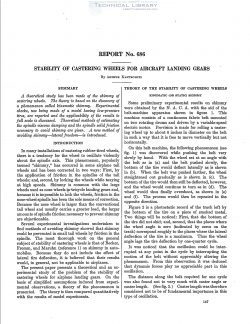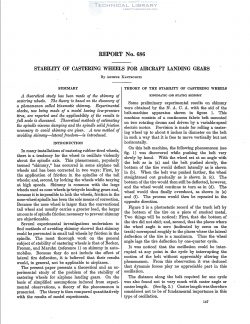naca-report-686

- Version
- 215 Downloads
- 1.21 MB File Size
- 1 File Count
- August 30, 2016 Create Date
- August 30, 2016 Last Updated
National Advisory Committee for Aeronautics, Report - Stability of Castering Wheels for Aircraft Landing Gears

A theoretical study has been made of the shimmy of
castering wheels. The theory is based on the discovery of
a phenomenon called kinematic shimmy. Experimental
checks, use being made of a model having low-pressure
tires, are reported and the applicability of the results to
full scale is discussed. Theoretical methods of estimating
the spindle viscous damping and the spindle solid friction
necessary to avoid shimmy are given. A new method of
avoiding shimmy—lateral freedom—is introduced.
In many installations of castering rubber—tired wheels,
there is a tendency for the wheel to oscillate violently
about the spindle axis. This phenomenon, popularly
termed “shimmy,” has occurred in some airplane tail
wheels and has been corrected in two ways: First, by
the application of friction in the spindles of the tail
wheels; and, second, by locking the wheels while taxying
at high speeds. Shimmy is common with the large
wheels used as nose wheels in‘tricycle landing gears and,
because it is impossible to lock the wheels, friction in the
nose-wheel spindle has been the sole means of correction.
Because the nose wheel is larger than the conventional
tail wheel and usually carries a greater load, the larger
amounts of spindle friction necessary to prevent shimmy
are objectionable.
Several experimental investigations undertaken to
find methods of avoiding shimmy showed that shimmy
could be prevented in small tail wheels by friction in the
spindle. The most thorough work on the general
subject of stability of castering wheels is that of Becker,
Fromm, and Maruhn (reference 1) on shimmy in auto-
mobiles. Because they do not include the effect of
lateral tire deflection, it is believed that their results
would, in general, not be applicable to airplanes. .
The present paper presents a theoretical and an ex-
perimental study of the problem of the stability of
castering Wheels for airplane landing gears. On the
basis of simplified assumptions induced from experi-
mental observations, a theory of the phenomenon is
presented. The theory is then compared quantitatively
with the results of model experiments.
| File | Action |
|---|---|
| naca-report-686 Stability of Castering Wheels for Aircraft Landing Gears.pdf | Download |

Comment On This Post